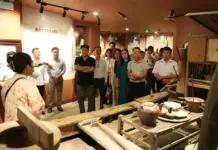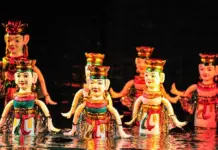The love affairs
“If you do not have a lover, go to Ha Pagoda then you will.” That is a common whisper to single people’s ears. The word of mouth makes Ha Pagoda different from other pagodas which the majority of visitors are middle-aged or old people. It is the favorite place for the young people who come to pray for love.
Although Ha Pagoda is not attached to any love story, many young people in Hanoi believe that they would find their other half if they pray for Buddha’s blessings here. There are many stories about people all over the country who find their other half and happiness after visiting the pagoda.
| Youth believe that they would find a ‘true love’ after worshipping at Ha Pagoda. Photo: Phat tu Hoa Sen |
One of them is Van Anh, a 25-year-old officer who was born in Hanoi but moved to live in Ho Chi Minh City as a kid. Being told about the pagoda from her family, she decided to visit it when she attended a friend’s wedding in Hanoi.
Only one week later, a man whom she had a crush on texted her on Facebook although they rarely had a conversation before. Then they started to date and decided to get married a few months later. “Since then, when I meet a single person, I recommend him or her to go to Ha Pagoda. I believe it can give good luck in love to people, the same as it did to me,” she said.
Another two sisters from Hanoi, 33-year-old Linh Van who had never had a relationship and 30-year-old Bich Ngoc who was divorced, also came to Ha Pagoda with a wish of luck in love. After one month, Van found her first boyfriend while Ngoc also met her second husband.
“I believe in the magical power of the pagoda,” Van said, “before visiting it, I always had bad luck in the relationship and now it is much better. It’s not easy to find Mr. Right so that it may fail sometimes. I will continue praying at the pagoda if this relationship won’t work. I believe that it would help me find someone to settle down finally.”
Nothing has proven such belief is true, but thanks to word of mouth, every day single people come here with the hope to find someone, couples pray for a long-lasting relationship or those who are unlucky in love wish to have more luck.
| The offerings for love at Ha Pagoda. Photo: Thanh Hai |
Ritual and belief
Visiting the pagoda, all usually come with three offering trays for being blessed.
The first one is for the Tam Bao place where Buddhas are worshipped, including incense, flowers, fresh fruits, and sweets. The second one is for the Deity, including votive money, tea, wine, and non-vegetarian food. The last one is for Mother Goddess, including fresh flowers, betel and areca (required), cakes, candies, and sponsored money.
Apart from incense and other things for the offerings, the rose, a symbol of love, is also available along the street as an “appropriate” flower to offer to pray for love and marriage.
| Ha Pagoda is situated at No 86 Chua Ha Street, Cau Giay District, Hanoi. Photo: Kinh te & Do thi |
Hidden in a small street in Cau Giay District, Ha Pagoda has two legends explaining its origin. One has it that King Ly Thanh Tong (1054-1072) ordered it to be built as a grateful gesture to Buddha. The forty-year-old king was barren until, after praying for Buddha’s blessing, his wife conceived a baby.
According to the other legend, the pagoda was built under King Le Thanh Tong (1442-1497) to commemorate the contribution of Nguyen Trai, Nguyen Xi and Dinh Liet, the national heroes who enthroned him in 1460.
Wars over time destroyed many parts of Ha Pagoda, but thanks to the donations from two wealthy families, it was restored in 1680.
Like other Buddhist temples in Vietnam which worship both Buddha and local deities, Ha Pagoda also has separated compartments dedicated to Buddha and Mother Goddess. In its yard, many old trees brought from India, the birthplace of Buddhism, were grown. Some of which are about 300 years old casting their shadows over the pagoda, creating a peaceful space in bustling Hanoi.






